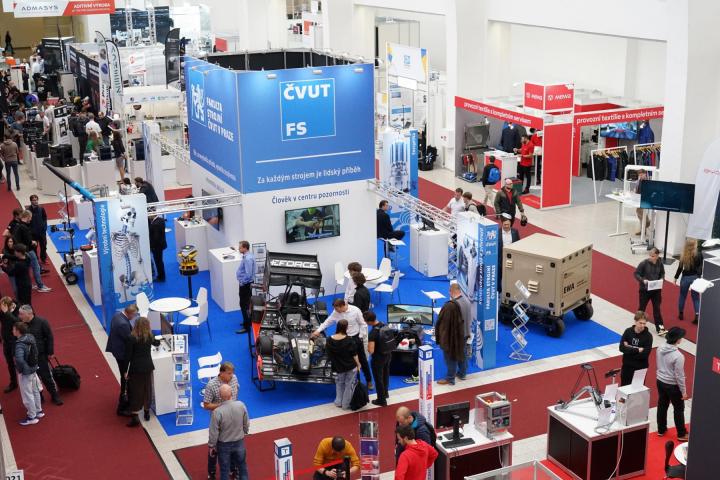
On the very first day of the fair, representatives of the Union of Slovak Scientific and Technical Societies presented the faculty with an award for "Best Scientific and Technical Presentation." The highlights of the exhibition were the revolutionary Catalyst turboprop engine, the EWA mobile device for extracting water from the air, and a model of the Hydronaut station for research in extreme environments. The faculty also provided ample space for student projects.
Catalyst – a new generation turboprop engine
The Faculty of Mechanical Engineering at the Czech Technical University in Prague played a significant role in the development of Avio Aero's advanced Catalyst turboprop engine. It is the first completely newly developed European turboprop engine for the 21st century, combining new technologies. The Catalyst engine brings radical change to the industry. It has a total pressure ratio of 16:1, which is the best ratio compared to the competition. It enables up to 18% lower fuel consumption and, at the same time, 10% higher thrust in cruise mode. This engine is the first turboprop engine whose parts are manufactured using 3D printing and is also equipped with a FADEC system for simultaneous control of engine and propeller power, which reduces the pilot's workload. The cooperation between the university and Avio Aero has significantly contributed to improving the quality of education for aviation industry professionals and to expanding the production of aircraft engines in the Czech Republic.
EWA – Mobile device for obtaining water from air
Scientists from the Faculty of Mechanical Engineering contributed to the development of the EWA (Emergency Water from Air) device, which was created at the University Center for Energy Efficient Buildings at the Czech Technical University in Prague (UCEEB). The EWA mobile device is the third generation of a system for obtaining water from air humidity. With a stable power supply, the average daily water production in the desert is 25 to 35 liters. In a more humid environment, it can produce 50 to 70 liters of water per day. The prototype device was tested in the laboratories of UCEEB CTU in Prague and in Australia. There, it generated an average of 25 liters of water per day.
Research for space missions
Hydronaut H03 DeepLab is a research and training station for human stays in extreme environments. The station enables simulations of analogous missions in isolated, extreme, and hazardous environments (ICE), such as space, the deep sea, or polar conditions. The Faculty of Mechanical Engineering at the Czech Technical University in Prague presented a 3D-printed model of this station. Our scientists addressed the most critical problems of the Hydronaut underwater station, in particular the high humidity in the station and the lack of knowledge about the exact state of the environment. To reduce air humidity, they developed a passive condensation system. They also developed a system for remote monitoring of the environment inside the station to increase crew safety.
Production technology for a better life
The exhibition also featured examples of orthopedic implants manufactured using 3D printing from beta titanium alloy with DLC coating. A DLC coating is applied to the sliding part of the implant. The surface designed for integration with bone thus mimics the trabecular structure of bone. Printing from beta titanium powder makes it possible to replace the standard Ti6Al4V ELI alloy. The introduction of an alloy without aluminum and vanadium eliminates the risk of toxic elements being released into the patient's body.
Support for energy education
The exhibition also featured the Cenelín project, a long-term student project aimed at creating a virtual nuclear power plant for educational purposes and the promotion of nuclear energy. The project involved the creation of a model of a virtual nuclear power plant with a VVER 1000 pressurized water reactor, based on the one located at the Temelín nuclear power plant. The individual components and systems are created by students and teachers as part of their semester work. The students presented the Cenelín project in a version for personal computers as well as with virtual reality glasses.
Our students' projects
The CTU Robotics student team presented a new generation of the PERUN Mars rover. Its main features are a robotic arm and a rocker-bogie chassis, which allows for good mobility in difficult terrain with low power consumption.
Another exhibit was a robotic manipulator, the result of a thesis by a student at the Faculty of Mechanical Engineering at the Czech Technical University in Prague. The aim of the thesis was to create a suitable platform for teaching robotics, additive technologies, and testing control algorithms. Students now use the robotic manipulator to learn programming and, above all, to comprehensively solve real automation tasks in accordance with the principles of Industry 4.0.
The second exhibit, created as a universal platform for studying various control algorithms and methods at the Institute of Instrumentation and Control Engineering, was the "Rotary Inverse Pendulum." The platform can be used for both teaching and research thanks to the variable complexity of the selected dynamic model.
The eForce Prague Formula student team's CTU 25 single-seater, capable of both piloted and autonomous driving, also attracted considerable interest from visitors. The Illustria rocket, which has also achieved excellent results in international competitions with the CTU Space Research team, attracted the same level of attention.
Participation in the International Engineering Fair in 2025 was extremely successful for the Faculty of Mechanical Engineering. During the fair, potential partners were convinced that the faculty has considerable innovative potential and can be a very useful partner for industry, not only in the Czech Republic.
(Translated with DeepL.com)





